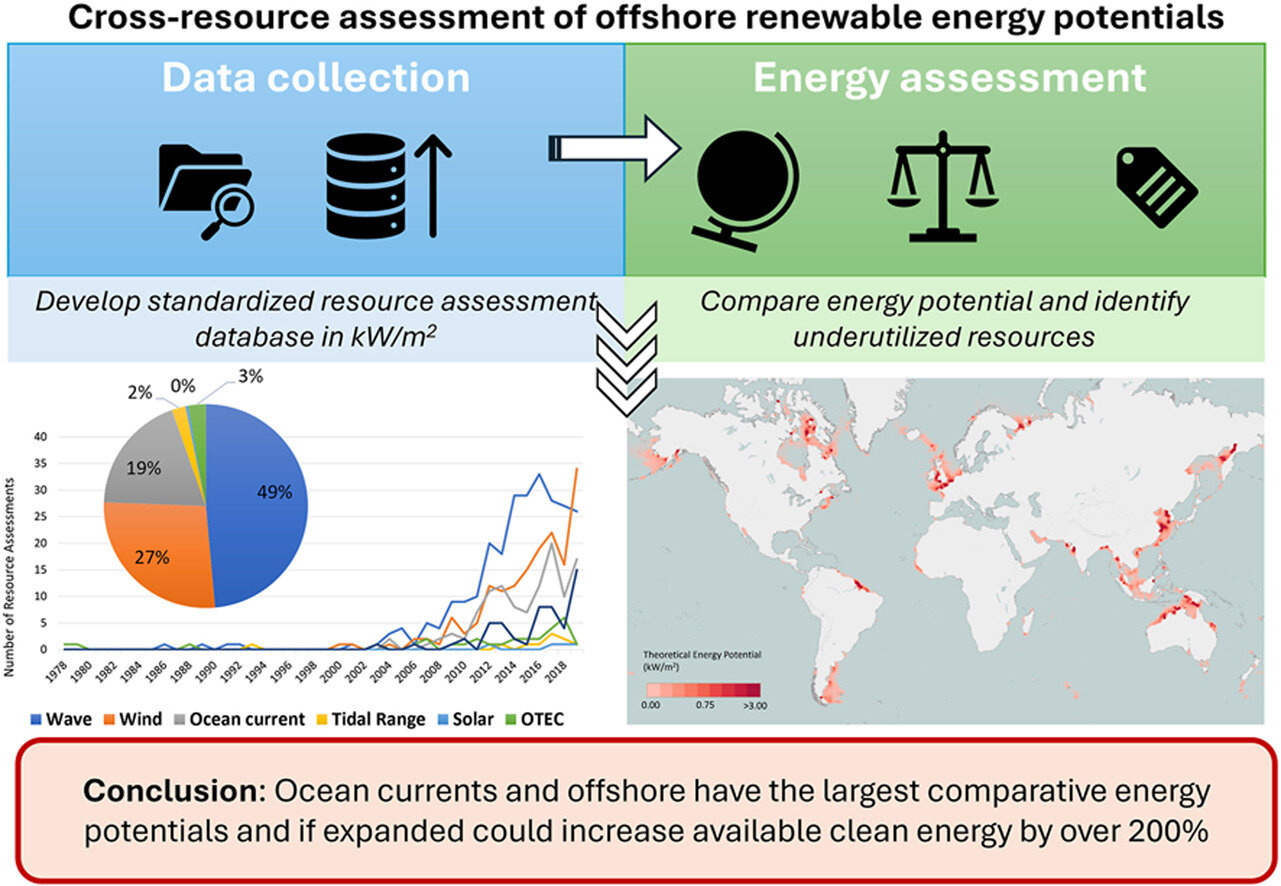In the quiet rhythm of Earth’s oceans, where tides rise and fall with celestial precision and sunlight dances endlessly across water, lies an energy reservoir so immense that it could rewrite the trajectory of climate change. And yet, until now, we’ve barely tapped into it.
According to groundbreaking new research from the Universities of Strathclyde and Maine, the planet may be sitting on an underutilized jackpot of clean energy. By harnessing just 2% of the global energy potential from tidal and offshore solar sources, humanity could make a meaningful dent in carbon emissions, accelerate the transition away from fossil fuels, and even fast-track progress toward the United Nations Sustainable Development Goals (SDGs). It’s a revelation that shifts the spotlight from well-trodden technologies like offshore wind to the unsung heroes of renewable energy: tides and ocean-borne sunlight.
660 Studies, 3,000 Sites, One Powerful Conclusion
To arrive at this insight, the researchers analyzed more than 660 individual assessments of offshore renewable energy potential across 3,000 global locations. From the Mediterranean to coastal Asia, the Pacific to the Atlantic, the team compiled data on six offshore renewable energy (ORE) sources: offshore wind, wave energy, tidal currents, offshore solar, ocean thermal energy conversion (OTEC), and ocean currents.
What emerged from this global synthesis was both surprising and enlightening. While offshore wind and wave energy dominate existing research and development—comprising over 75% of studies—they are not the most promising sources in terms of raw, dependable energy. That title goes to tidal and offshore solar energy, both of which consistently demonstrated greater resource potential across multiple regions and scenarios.
Even more intriguingly, the researchers converted all energy measurements into a standardized unit: kilowatts per square meter (kW/m²). This allowed them to directly compare different technologies and locations on an even playing field, an innovation that makes this study the first truly comprehensive global assessment of its kind.
Why Tidal and Offshore Solar Shine Brightest
Tidal energy has long been the quiet achiever of renewables. Unlike wind and solar, which are vulnerable to daily and seasonal variability, tides operate on predictable lunar and solar cycles. This makes them not just a powerful source, but a stable and reliable one—an energy form whose timing can be forecast years in advance. It’s the metronome of the planet, steadily pumping kinetic energy through ocean basins with every ebb and flow.
Offshore solar, meanwhile, is a more recent addition to the renewable conversation. But in tropical and subtropical regions, where sunlight strikes the sea with clockwork consistency, it offers extraordinary potential. Freed from the land constraints and cloud cover that limit terrestrial solar installations, floating solar panels on calm ocean surfaces can generate high yields while cooling naturally in the surrounding water—enhancing their efficiency.
Perhaps most important of all, both tidal and offshore solar technologies are remarkably equitable. Unlike some other forms of energy, they are not geographically limited to only a handful of wealthy, technologically advanced nations. Instead, these resources are distributed across many developing countries, giving them a chance to leapfrog into a clean energy future without depending on costly imports or high-emission fuels.
A Modest Slice, A Massive Impact
The study’s authors wanted to know: if the world captured just 2% of the energy from tidal and offshore solar sources, what would happen?
The answer was astonishing. At 2019 levels of global carbon emissions, that tiny sliver of resource potential would reduce CO₂ output by 0.299 gigatons per year. Over time, this would add up. If sustained, this rate of emission reduction would lead to net-zero emissions within 68 years—without even accounting for the cumulative benefits of technological innovation, cost reductions, and policy alignment.
While 68 years may sound like a long time, it’s a breathtaking achievement for such a modest investment in underexplored technology. And this is just the beginning. Scaling to 5% or 10% utilization of these resources would dramatically accelerate the timeline and widen the impact.
Technology Versus Potential: A Critical Mismatch
Why, then, are tidal and offshore solar still largely on the sidelines?
Part of the answer lies in technological maturity. Offshore wind farms, for instance, have been operating commercially for over two decades. Their engineering challenges—though immense—have largely been met, and their economics are steadily improving. The infrastructure, financing, and political support exist to continue expanding offshore wind rapidly.
Tidal and offshore solar, by contrast, are relatively young. Tidal power plants are often expensive and environmentally sensitive to build, particularly when they involve damming estuaries or constructing underwater turbines in complex marine ecosystems. Offshore solar arrays are still in experimental phases, with only a handful of small-scale demonstration projects worldwide.
But the researchers argue that this mismatch between technical readiness and resource potential is a strategic blind spot. We are investing heavily in what is easy and familiar, rather than what is most abundant and most reliable in the long term. As James Spalding, lead author and PhD researcher at Strathclyde, put it: “Our research highlights the value of assessing where the greatest resource potential exists, rather than limiting development to what is currently most technologically mature.”
In other words, it’s time to stop following the path of least resistance—and start looking where the real energy is.
A Climate Roadmap Anchored in Water and Light
The implications for global climate targets are profound. According to existing projections, at least 60% of global electricity must come from renewables by 2030, and 80% by 2050, if the world hopes to meet its climate commitments under the Paris Agreement. Yet, as of 2019, only 23% of global energy was renewable—and a tiny fraction of that came from ocean-based sources.
Meanwhile, more than half of existing ocean energy projects are concentrated in Europe, where supportive policy environments and mature technologies dominate. This geographic clustering highlights another major challenge: a lack of investment, research, and political will in regions that actually have more abundant natural resources.
Many low-income coastal nations—particularly in the southern hemisphere—could benefit from ORE deployment not just environmentally, but economically. By investing in tidal and offshore solar infrastructure, these nations could gain energy independence, create local jobs, and sidestep the expensive burden of importing fossil fuels. It’s a development strategy aligned not just with climate goals, but with social equity.
The Ocean Blueprint for a Decarbonized World
What the Strathclyde-Maine study offers is more than just a recalibration of energy priorities. It’s a blueprint for decarbonization that embraces the diversity of planetary systems.
By taking a multiregional, multi-technology approach, the study shows how tidal and offshore solar can serve as backbones of regional energy systems. For example, in the eastern North Atlantic, tidal currents offer consistent power for countries like the UK and France. In coastal Asia, abundant sunlight and calm seas could support vast floating solar platforms. In the Mediterranean, a combination of wave and offshore solar might offer the best blend. The key is tailoring energy strategies to geography, rather than applying a one-size-fits-all model.
This approach doesn’t just help us diversify our energy mix—it builds resilience. In a world increasingly affected by extreme weather, political instability, and supply chain disruptions, distributed energy systems based on local renewable sources are more secure, more flexible, and more sustainable.
Next Steps: Research, Investment, and Policy Shift
For the potential of tidal and offshore solar to be realized, the next steps are clear. First, we need more research funding dedicated to developing and scaling these technologies. Pilot projects must move beyond the demonstration phase and into commercial viability, backed by public and private investment.
Second, there must be a policy shift. Governments and multilateral organizations must start treating ORE as a core component of climate and energy planning, rather than a fringe interest. This means establishing favorable regulations, offering incentives, and creating streamlined approval processes for tidal and offshore solar projects.
Third, the global energy narrative needs updating. The dominance of wind and solar (on land) in the public imagination has been a success story—but also a limitation. As the climate clock ticks louder, we can no longer afford to ignore the deep blue frontier.
The Ocean’s Promise
Tides have been rolling for billions of years. The sun has been shining longer still. And both will continue, long after human civilizations have risen and fallen. What this study reminds us is that the answers to some of our most urgent questions may not lie in distant technologies or expensive geoengineering—but in the elemental rhythms of Earth itself.
The ocean is not just a threat, rising slowly with the warming of the planet. It is also a vast battery, pulsing with clean, renewable power. In the tides and in the sunlight that skims the sea’s surface, there is hope.
We need only reach for it.
Reference: Spalding James et al, A global cross-resource assessment of offshore renewable energy, Renewable and Sustainable Energy Reviews (2025). DOI: 10.1016/j.rser.2025.115563






